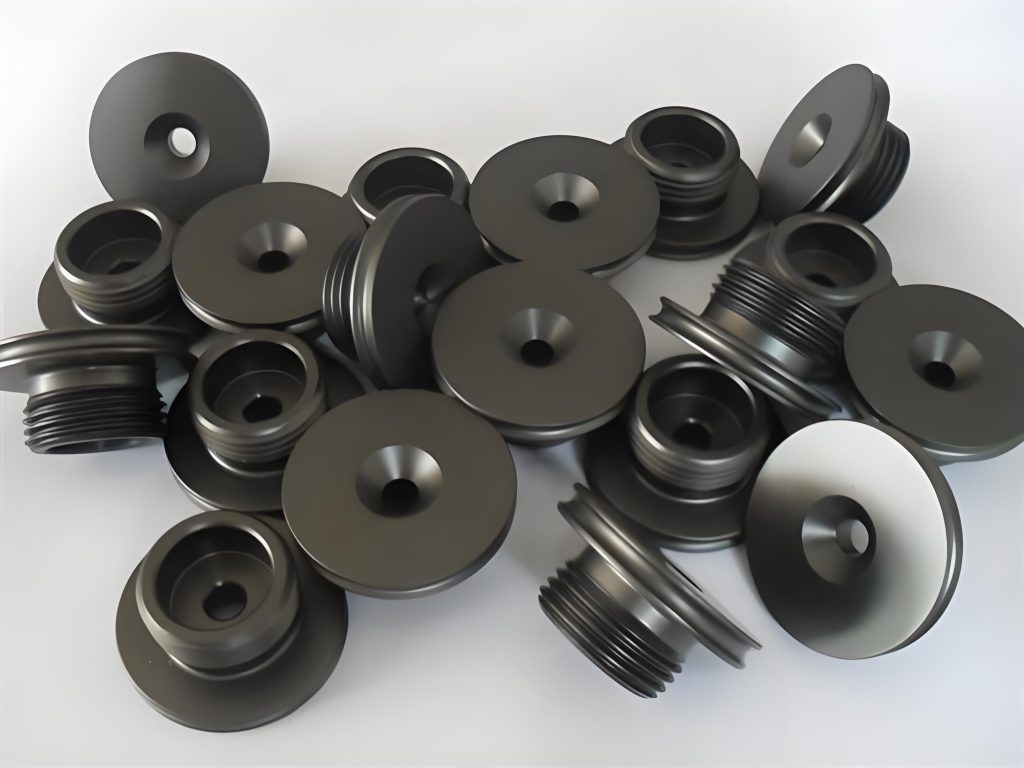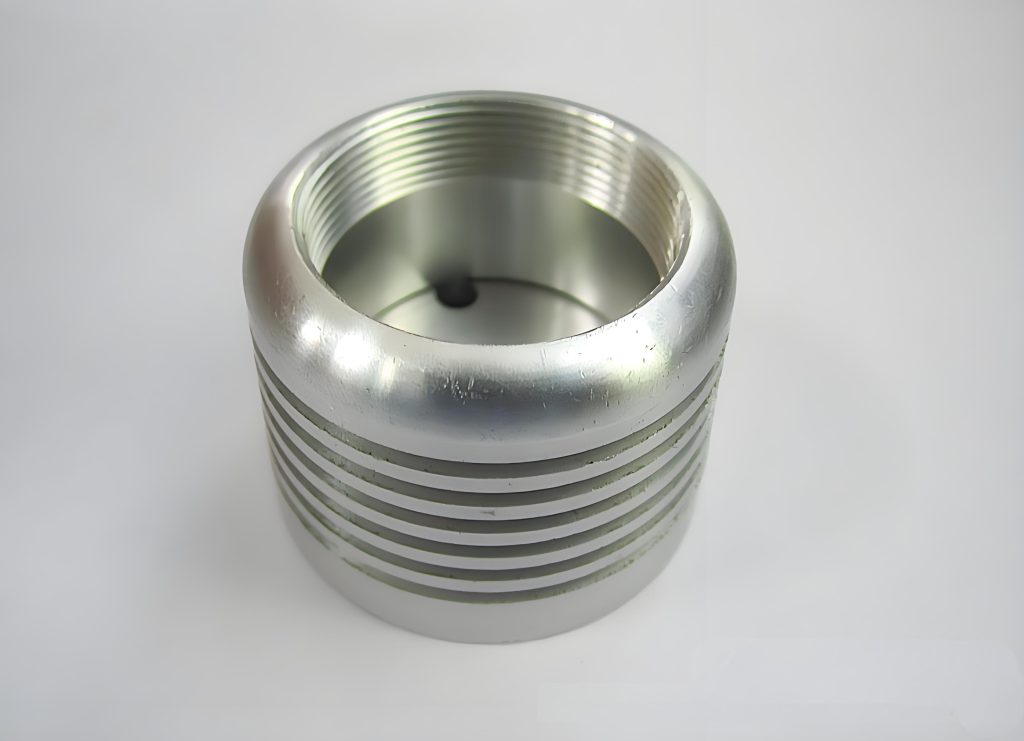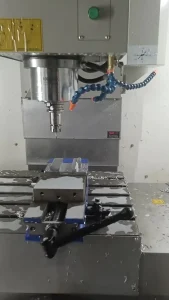抽象的
本文全面分析了 CNC铝加工公差. 确定了决定这些公差的关键因素, 包括机加工设备, 切削参数, 材料特性, 和质量控制措施. 具有先进控制系统的高精度机器可以实现更严格的公差. 优化切削参数至关重要. 不同的铝合金特性和铝的晶粒结构对加工精度起着重要作用. 质量控制措施对于确保一致的公差至关重要. 严格的加工公差带来许多好处. 未来的研究可能集中在先进技术, 新材料和刀具涂层, 不同的加工环境, 混合制造工艺, 更有效的质量控制方法, 不同的加工策略, 工件装夹方式, 冷却剂和润滑, 后加工工艺, 以及实时监控和反馈系统,不断提高公差.

一个、介绍
1.1 研究背景
CNC铝加工公差在精密制造中起着至关重要的作用. 目前的研究重点是影响这些公差的各种因素.
在当今竞争激烈的制造业, 实现精确的公差对于确保产品的质量和功能至关重要. CNC铝加工广泛应用于航空航天等各个领域, 汽车, 和电子产品由于其高精度和高效率.
加工公差的确定受多种因素影响. 关键决定因素之一是加工工艺本身. 不同的加工方法, 比如铣削, 转动, 和钻孔, 具有不同的精度等级,会影响产品的最终公差. 例如, 与其他一些方法相比,铣削可以实现更严格的公差.
另一个重要因素是原材料的质量. 具有一致性能的高质量铝合金有助于提高加工公差. 铝合金的特点, 比如硬度, 延展性, 和导热系数, 会影响加工过程和由此产生的公差.
零件的设计也起着重要作用. 复杂的几何形状和严格的公差可能更具挑战性,并且可能需要先进的加工技术和工具. 此外, 切削刀具的选择及其磨损会影响加工公差. 磨损的工具可能会导致与所需尺寸的偏差增加.
据研究, 根据应用和要求,加工公差范围可以从几微米到几毫米. 例如, 在航空航天业, 关键部件可能需要小于 0.01 毫米的极其严格的公差,以确保安全和性能. 相比之下, 一些通用应用程序可能会容忍更大的公差.
了解和控制这些因素对于制造商实现所需的加工公差并生产高质量的产品至关重要. CNC 铝加工领域的持续研发专注于改进加工工艺, 优化工具, 并开发新材料以进一步提高精度并减少公差.
1.2 研究目标
本研究的目的是彻底分析和了解决定CNC铝加工公差的各种因素. 这种理解对于改进制造工艺和确保生产高质量铝部件至关重要.
主要因素之一是所使用的机械加工设备. 具有先进控制系统的高精度机器可以实现更严格的公差. 例如, 具有精确定位系统和稳定主轴转速的机器可以最大限度地减少加工过程中的偏差. 根据行业数据, 具有先进控制技术的机器可以将加工公差减少多达 50% 与旧型号相比.
切削参数也起着重要作用. 切削速度等参数, 进给率, 切削深度和切削深度会影响加工零件的表面光洁度和尺寸精度. 这些参数的优化选择需要全面了解材料特性和加工要求. 研究表明,切削参数的适当组合可以将加工公差提高多达 30%.
机械师的技能和经验是另一个重要的决定因素. 熟练的机械师可以根据实时观察来调整加工过程,并进行必要的调整以达到所需的公差. 他们还可以在潜在问题导致重大偏差之前检测并纠正它们.
温度和湿度等环境因素也会影响加工公差. 温度变化会引起工件和机床的热膨胀或收缩, 导致尺寸变化. 维持稳定的环境有助于减少这些影响. 例如, 在一些精密加工设施中, 温度控制在较窄的范围内,以确保加工公差一致.
通过分析这些因素并了解它们对数控铝加工公差的影响, 制造商可以采取适当的措施来改进其制造工艺. 这可能包括投资先进的加工设备, 优化切削参数, 为机械师提供培训, 和控制加工环境. 最终, 这将导致生产具有更严格公差和更好性能的高质量铝部件.
乙、CNC 铝加工公差: 定义和重要性
2.1 什么是加工公差?
加工公差是指加工零件尺寸的允许偏差. CNC铝加工背景下, 这些公差决定了与所需尺寸的可接受偏差范围. 例如, 如果零件设计为具有特定长度, 宽度, 和身高, 加工公差定义了实际尺寸与这些理想值的偏差程度.
2.1.1 工程中的公差
在机械工程领域, 公差对于确保部件的正常运行和组装起着至关重要的作用. 在 CNC 铝加工中, 出于多种原因,公差至关重要. 例如, 制造航空航天应用零件时, 需要严格的公差以确保飞机的安全和性能. 即使关键部件尺寸的微小偏差也可能导致灾难性后果. 在汽车行业, 精确的公差对于发动机零件和其他部件的正确配合和功能是必要的. 活塞或气缸尺寸的微小变化可能会导致发动机效率降低和磨损增加.
2.1.2 严格公差的重要性
保持铝零件严格的加工公差有几个好处. 首先, 确保零件的互换性. 当零件在较窄的公差范围内制造时, 它们可以轻松组装和更换,无需大量安装或修改. 这在一致性和可靠性至关重要的大规模生产环境中尤其重要. 第二, 严格的公差提高了产品的性能和耐用性. 例如, 在电子行业, 尺寸精确的元件可以提供更好的电气绝缘和散热, 提高可靠性并延长使用寿命. 此外, 严格的公差可以减少浪费和生产成本. 通过最大限度地减少与所需尺寸的偏差, 制造商可以减少废料和返工量, 从而实现更高效的生产流程.
根据行业数据, 以严格公差制造的零件可以达到 30% 与公差较宽松的产品相比,使用寿命更长. 例如, 在航空航天业, 具有极其严格公差的部件可以承受更高的应力和疲劳载荷, 从而提高安全性和可靠性. 在医疗器械行业, 精确的公差对于确保手术器械和植入物的准确性和功能至关重要.
综上所述, 了解和控制 CNC 铝加工公差对于生产具有一致性能和可靠性的高质量产品至关重要. 通过定义明确的公差并实施适当的制造工艺和质量控制措施, 制造商可以确保其产品符合最高的质量和功能标准.
2.2 公差是如何确定的?
CNC 铝加工的公差是通过多种方法和因素来确定的.
2.2.1 技术方面
机器精度是至关重要的技术因素. 具有先进控制系统的高精度数控机床可以实现更严格的公差. 例如, 具有精确定位系统的机器可以确保切削刀具精确地放置在所需位置, 最大限度地减少机加工零件的偏差. 据研究, 具有亚微米定位精度的机器可以显着降低加工公差. 工具也起着至关重要的作用. 切削刀具的质量和状况会影响公差. 具有锋利边缘和一致几何形状的高质量刀具可以产生更精确的切割. 此外, 刀具材料的选择, 例如硬质合金或金刚石涂层工具, 可能会影响加工公差,具体取决于所加工铝合金的硬度和延展性.
2.2.2 材料特性
铝的特性对加工公差有重大影响. 具有一致化学成分和机械性能的铝合金有助于提高公差. 例如, 热膨胀系数低的合金不太可能因加工过程中的温度变化而发生尺寸变化. 铝合金的硬度和延展性也会影响加工过程. 软合金可能更容易变形, 而硬质合金可能需要更大的力并可能导致工具磨损, 这两者都会导致公差的变化. 根据行业数据, 不同的铝合金的加工公差变化可达 20%. 此外, 原材料的表面光洁度会影响公差. 光滑的表面可以实现更一致的加工和更严格的公差.

C、影响CNC铝加工公差的因素
3.1 材质特性
铝是一种用途广泛的金属,具有多种成分和特性, 这会显着影响加工公差.
3.1.1 合金变化
不同的铝合金具有不同的特性,会影响加工公差. 例如, 某些合金可能具有更高的强度和硬度, 这会使它们更难以加工并可能导致更大的公差. 根据行业数据, 与 3003-H14 等较软的合金相比,7075-T6 等合金具有更高的强度重量比,但可能需要更精确的加工参数才能实现严格的公差. 另一方面, 较软的合金在加工过程中可能更容易变形, 也影响公差. 此外, 合金的化学成分会影响其切削加工性. 铜或镁含量较高的合金可能具有不同的导热性和切削特性, 影响加工过程中产生的热量,从而影响零件的尺寸稳定性.
3.1.2 晶粒结构
铝的晶粒结构对加工精度有重大影响. 细晶粒结构通常会产生更好的加工公差,因为它提供更均匀的材料特性并减少不一致切削的可能性. 例如, 细晶粒铝合金材料的硬度和延展性变化较小, 实现更一致的加工和更严格的公差. 相比之下, 粗粒结构可能会导致切割不均匀,并可能导致与所需尺寸的较大偏差. 晶粒结构也会影响机加工零件的表面光洁度. 更细的晶粒结构可以产生更光滑的表面, 这对于需要严格公差和良好表面质量的应用来说通常是理想的. 而且, 晶粒的取向会影响加工性能的方向性. 例如, 如果切割方向平行于纹理方向, 与垂直于晶粒时相比,它可能会导致不同的加工特性. 据研究, 通过热处理或其他工艺优化晶粒结构可以将加工公差提高多达 20%.
3.2 加工参数
加工参数在确定 CNC 铝加工公差方面起着至关重要的作用. 这些参数包括切削速度, 进给率, 和切削深度.
3.2.1 最优参数选择
选择最佳加工参数对于实现所需的公差至关重要. 切削速度是指切削刀具沿工件移动的速度. 较高的切削速度可以提高生产率,但也可能导致发热和刀具磨损增加. 用于铝加工, 适当的切削速度范围可以是 100 到 500 米每分钟, 取决于合金和加工操作. 进给速率是刀具前进到工件中的速率. 较高的进给率也可以提高生产率,但可能会导致表面光洁度更粗糙和公差更大. 用于铝, 进给速度为 0.1 到 0.5 通常使用每齿毫米数. 切削深度是刀具单次切入工件的距离. 更深的切削深度可以提高材料去除率,但可能会导致更多的振动和刀具偏斜, 导致更大的公差. 用于铝加工, 切削深度为 1 到 5 经常使用毫米.
3.2.2 参数变化的影响
加工参数的变化会显着影响公差水平. 例如, 提高切削速度会导致热量产生增加, 这会引起工件和刀具的热膨胀. 这可能会导致更大的公差. 另一方面, 降低切削速度可以减少热量产生,但也可能降低生产率. 相似地, 提高进给速度会导致更粗糙的表面光洁度和更大的公差, 虽然降低进给率可以提高表面光洁度,但也可能降低生产率. 切削深度的变化也会影响公差. 更深的切削深度会导致更多的振动和刀具偏转, 导致更大的公差. 据研究, 一个 10% 提高切削速度可将公差水平提高多达 5%, 而一个 10% 进给率的增加可将公差水平提高多达 10%. 一个 10% 增加切削深度可将公差水平提高多达 15%. 所以, 仔细选择和控制加工参数以实现所需的公差,同时保持生产率非常重要.
D、提高 CNC 铝加工公差
4.1 质量控制措施
质量控制对于确保数控铝加工中一致的加工公差至关重要. 它涉及一系列措施和流程来监视和控制加工零件的质量.
4.1.1 检查技术
检验工具和技术在验证公差方面发挥着至关重要的作用. 一些常见的检查工具包括千分尺, 卡尺, 和坐标测量机 (三坐标测量机). 使用千分尺和卡尺高精度测量尺寸, 而坐标测量机可以提供精确的三维测量. 根据行业数据, CMM 可以测量尺寸,精度高达几微米. 除了这些工具, 目视检查还可用于检查表面缺陷和其他质量问题.
其他检测技术包括超声波检测和X射线检测等无损检测方法. 这些方法可以检测内部缺陷并确保加工零件的完整性. 例如, 超声波检测可用于检测铝部件中的裂纹和空隙, 而X射线检查可用于检查内部孔隙度.
4.1.2 流程优化
优化加工工艺的策略可以显着提高公差. 一种方法是使用先进的加工技术,例如高速加工和微加工. 高速加工可以提高生产率并减少刀具磨损, 而微加工可以实现极其严格的公差. 例如, 微加工可用于生产公差小至几微米的零件.
另一个策略是优化切削参数. 正如前面所讨论的, 切割速度, 进给率, 切削深度会影响公差. 通过仔细选择和控制这些参数, 制造商可以在保持生产力的同时实现更好的公差. 例如, 使用较低切削速度的组合, 更高的进给率, 浅切削深度可以减少热量产生和刀具磨损, 导致更严格的公差.
此外, 工具管理对于流程优化也很重要. 定期检查和更换切削刀具可以确保刀具质量一致并减少刀具磨损. 据研究, 更换磨损的刀具可以将加工公差提高多达 20%. 而且, 使用先进的刀具涂层和材料可以延长刀具寿命并提高加工性能.
最后, 过程监控和反馈系统可用于实时检测和纠正偏差. 这些系统可以监控切削力等参数, 振动, 和温度, 并向加工过程提供反馈. 例如, 如果切削力超过某个阈值, 系统可以调整切削参数以减少刀具磨损并提高公差.
4.2 未来趋势与挑战
随着制造业的不断发展, 在 CNC 铝加工中实现更严格的加工公差变得越来越重要. 本节将探讨该领域的新兴趋势和挑战.
4.2.1 先进技术
新技术在改善数控铝加工公差控制方面具有巨大潜力. 例如, 可以采用人工智能和机器学习算法来优化加工参数. 通过分析先前加工操作的大量数据, 这些技术可以预测最佳切割速度, 进给率, 以及特定铝合金和零件几何形状的切削深度, 从而减少公差. 据研究, 使用机器学习可以将加工公差提高多达 30%.
增材制造, 也称为 3D 打印, 是另一种可以补充 CNC 加工的新兴技术. 结合增材和减材技术的混合制造工艺可以提供更大的设计灵活性和可能更严格的公差. 例如, 增材制造可用于创建使用传统方法难以加工的复杂几何形状, 而可以使用CNC加工来达到最终的精度.
纳米技术也正在进入机械加工行业. 切削刀具上的纳米涂层可以提高刀具寿命和切削性能, 导致更严格的公差. 此外, 纳米级加工工艺可用于在铝零件上创建极小且精确的特征. 然而, 这些技术仍处于发展的早期阶段,面临成本高、可扩展性有限等挑战.
4.2.2 行业需求
行业对数控铝加工更高精度的需求不断发展. 在航空航天领域, 例如, 对轻质和节能飞机的需求正在推动先进铝合金和更严格的加工公差的发展. 发动机零件和结构元件等部件需要极其精确的尺寸,以确保最佳性能和安全性. 根据行业数据, 航空航天工业要求关键部件的加工公差小于0.01毫米.
在电子行业, 设备的小型化推动了对散热器中使用的铝部件的更严格公差的需求, 外壳, 和连接器. 随着设备变得更小、功能更强大, 对高效散热和可靠电气连接的需求变得更加重要. 严格的加工公差可以确保这些部件的正确配合和功能, 提高电子设备的性能和可靠性.
为了满足这些不断变化的需求, 制造商必须持续投资研发以改进加工工艺和技术. 这包括与研究机构和供应商合作开发新材料, 工具, 和流程. 此外, 制造商还必须培训员工使用先进技术并实施质量控制措施,以确保一致的加工公差.
综上所述, 在数控铝加工中实现更严格的加工公差是一项持续的挑战,需要采用先进技术并能够满足行业不断变化的需求. 紧跟新兴趋势并投资创新, 制造商可以确保其竞争力并生产具有广泛应用所需精度的高质量铝部件.

乙、结论与展望
5.1 研究结论总结
这项研究提供了 CNC 铝加工公差的全面分析. 我们已经确定了决定这些公差的几个关键因素, 包括机加工设备, 切削参数, 材料特性, 和质量控制措施.
具有先进控制系统的高精度机器可以实现更严格的公差. 切削速度等切削参数的优化选择, 进给率, 切削深度对于在保持生产率的同时实现所需的公差至关重要. 不同的铝合金具有不同的特性,会影响加工公差, 而且铝的晶粒结构对加工精度也起着很大的作用. 检查技术和工艺优化等质量控制措施对于确保一致的加工公差至关重要.
根据行业数据和研究结果, 严格的加工公差具有多种优势, 包括提高零件的互换性, 增强产品的性能和耐用性, 并减少浪费和生产成本. 以严格公差制造的零件可以达到 30% 与公差较宽松的产品相比,使用寿命更长.
综上所述, 了解和控制 CNC 铝加工公差对于生产具有一致性能和可靠性的高质量产品至关重要. 通过实施适当的制造工艺和质量控制措施, 制造商可以确保其产品符合最高的质量和功能标准.
5.2 未来的研究方向
建议未来研究改善 CNC 铝加工公差的可能领域.
未来的研究可以集中于进一步开发人工智能和机器学习算法等先进技术,以更准确地优化加工参数. 此外, 对新材料和刀具涂层的研究可以提高加工性能和更严格的公差. 研究不同加工环境的影响, 例如温度和湿度控制, 关于公差也可以提供有价值的见解. 而且, 探索结合增材和减材技术的混合制造工艺的潜力,可以为在复杂几何形状中实现更严格的公差提供新的解决方案. 另一个研究领域可能是开发更有效的质量控制方法和检查工具,以确保批量生产中的公差一致. 通过解决这些领域, 未来的研究可以为数控铝加工公差的不断提高和高质量铝部件的生产做出贡献.






